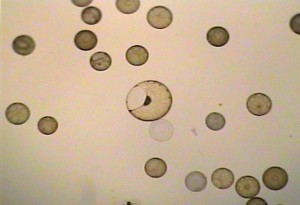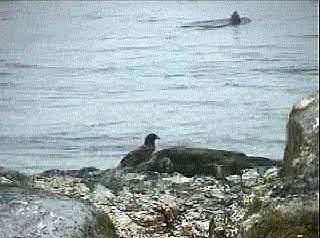Garry and Chris out with Shelby Davis and Mrs Davis, and other guests. Tour of buildings and explanation of the racerocks.com technology.
8 visitors today

Garry and Chris out with Shelby Davis and Mrs Davis, and other guests. Tour of buildings and explanation of the racerocks.com technology.
8 visitors today
 Scientific classification
Scientific classification
Kingdom: Chromalveolata
Phylum: Heterokontophyta
Subphylum: Bacillariophyceae
Class: Coscinodiscophyceae
Order: Coscinodiscales
Family: Coscinodiscaceae Kützing, 1844
Genus: Coscinodiscus Ehrenberg, 1839
Species: radiatus?
Coscinodiscus radiatus
and Image File |
 The Race Rocks taxonomy is a collaborative venture originally started with the Biology and Environmental Systems students of Lester Pearson College UWC. It now also has contributions added by Faculty, Staff, Volunteers and Observers on the remote control webcams. The Race Rocks taxonomy is a collaborative venture originally started with the Biology and Environmental Systems students of Lester Pearson College UWC. It now also has contributions added by Faculty, Staff, Volunteers and Observers on the remote control webcams.
Garry Fletcher |
Coast Guard 359 dropped off two techs to service the automated nav. aids
16 visitors today
Two elephant seals haul out on the lawn and provide evidence of mating behaviour. The female has a large cut around her neck indicating an old injury. (Scarlet)
On January 22, 2004 Mike and Carol Slater moved camera 3 over to their house in order to keep track of the male elephant seal, Mirounga angustirostris who has been hauled out on Great Race Rocks recently. They took these images right outside their house. He is the same one (Slash) who was injured a year ago.. See the video footage from January 03, and from August 03
This was the first time an adult female had come up to join him on the lawn. That afternoon there was considerable maneuvering for reproductive purposes.
It turns out that the female has also had an extensive injury. This deep cut, now healing over has probably been caused by a fish net or rope. We have not observed this female before at Race Rocks. She may have been hauled up on the Middle island where they lie on the flat top part and are not very visible from a boat. ( Later, Pam Birley gave this female the name of Scarlet
In 2009, we believe this same female elephant seal has again shown up on Middle Island
2004-01-24′,’23:04:20′,’Two elephant seals haul out on the lawn and provide evidence of mating behaviour. See http://www.racerocks.com/racerock/marmam/elseal/elsealmate.htm The female has a large cut around her neck indicating an old injury :Garry.
Jan 24 2004: Two elephant seals haul out on the lawn and provide evidence of mating behaviour. See http://www.racerocks.com/racerock/marmam/elseal/elsealmate.htm The female has a large cut around her neck indicating an old injury.
We received the pictures for this file attached to an e-mail from Pam Birley, a regular observer from England on our cameras. She saved these images from our remote camera so we have quoted her e-mail here describing the events as they unfolded…….
. ” On January 22/04, it was a peaceful scene on the cliff with a large group of cormorants and a grazing goose….when suddenly a young bald eagle swooped down and made a meal of one of the birds….
Note that the cormorants were swimming out beyond their perch at this point as the eagle stands on his prey . …..A passing seal kept popping up to see what was going on….
…….and when the eagle had finished its meal it flew off, leaving the rest of the carcas for the seagulls to finish off.. Quite a little drama. What a fantastic site – always something of interest”
….Pam goes on to say…” Do you know where the elephant seal is (we call him Big Guy) – I can hear him but can’t find him on the cam – he was under that rock for about a week. I belong to Whale Watchers Group on Yahoo, most of us being addicts of Orca-Live.com during the summer and we have been pasting some RR captures on that site. We do give credit to you of course and we are spreading the word about your excellent website. Thank you so much !!! .”….
(ed. note) : Well thank you Pam! We really value your observation and quick action in recording these scenes and sending them along to us as an e-mail attachment. One of our Japanese students has suggested the name “Debu” (Fatty in Japanese) for the elephant seal that spends much of his time up on the main island. If you can hear him but not see him, he is hauled out just out of range of the camera on the North side of the house. He likes the soft long grass of one of the lawns. See the marine mammals archives for several videos of this elephant seal who was badly injured last year.
Thrift is a native plant which grows in the salt spray zone at Race Rocks .
Scientific classification
Kingdom: Plantae
(unranked): Angiosperms
(unranked): Eudicots
(unranked): Core eudicots
Order: Caryophyllales
Family: Plumbaginaceae
Genus: Armeria
Species: A. maritima
Armeria maritima (Mill.) Willd.
Other Members of the Angiosperms at Race Rocks.
and Image File |
 The Race Rocks taxonomy is a collaborative venture originally started with the Biology and Environmental Systems students of Lester Pearson College UWC. It now also has contributions added by Faculty, Staff, Volunteers and Observers on the remote control webcams. The Race Rocks taxonomy is a collaborative venture originally started with the Biology and Environmental Systems students of Lester Pearson College UWC. It now also has contributions added by Faculty, Staff, Volunteers and Observers on the remote control webcams.
–Garry Fletcher |
OBJECTIVES: After doing this field lab, students will be able to:
1. Quantify various aspects of the ecological niche of a seabird.
2. Do statistical comparisons using several sets of data collected in the field.
3. Demonstrate an ability to plan the procedure of an investigation.
PROCEDURE:
1. We will collect the evidence for predation in the vicinity of one of the current years oystercatcher nests at Race Rocks Marine protected Area. A previous class may have already done this for you.
2. Your class will be asked to decide on how to analyze this evidence in order to quantify as many aspects as possible about the ecological niche of the oystercatcher. Write down your plans for the investigation before starting.
3. Some hints for your planning:
— How can we estimate the biomass of the food species?
— Are all the prey species at the same trophic level?
— Can you tell something about energy expended by the bird in foraging by looking at the range of the mussel sizes?
— Just how much force (energy) does it take to extract at intertidal organism from it’s habitat?
— What can you contribute in terms of scientific information to this web page?
–Can we make a dichotomous key for identification of the prey species?
–How can we apply the concepts of pyramids of numbers, biomass , and energy with our information?
4. See the results of the Fall 1999 collection of shells from the midden of the oystercatchers. Use these results to help in the planning of this lab. It is assumed you will be able to build on these results and go further in the investigation.
5. –Use the diversity index calculator from the Maryland Sea Grant Extension Program at the Center of Marine Biotechnology to compare the two year’s data. Explain how we may use a diversity index such as this as a monitor of various environmental concerns. Be sure to see the page which describes the application of various indices of diversity.
Other possibilities:
— Use the “Odum” energy symbols to model the ecological Niche of the Black Oystercatcher. (remember – there are NO oysters at Race Rocks!–Can some further media production be done on the oystercatchers?
2004-01-09′,’17:09:52′,’Over 250 Northern Sea Lions ( many juveniles) on middle rock only today- One large male elephant seal there also and one on Great Race – ( On the lawn near helipad- check on the robotic camera ) Several bald eagles on the rocks.